Britain is in decline. This much is true. Nobody would dare suggest otherwise – unless, of course, they wish to attest to pure ignorance or twisted glee.
Given this, we are very much in need of sweeping reform. Yet reform is not the product of drawn-out pontification. Ultimately, it is the sum of action: action moulded by proposition.
As such, dear reader, allow me to do just that. May I present to you: A Sensible Proposal.
Shrink the cabinet to its 5 or 6 most capable members, empower ministers to fire civil servants at will, and slash the civil service by at least 75% – it’s not technically Moldbuggian RAGE (Retire All Government Employees), but it’s of the same spirit.
Take the Civil Service Code and throw it on the regulatory bonfire, along with every obstructive procurement rule preventing us from becoming the AI capital of Europe.
Implement mandatory IQ tests for all new civil service hires and scrap the counter-intuitive stakeholder model of policy-making; ensuring government bureaucrats literally, not figuratively, live in The Real World.
Double the length of every sentence, especially for crimes which make civilised society impossible (murder, rape, theft, schmonking weed, etc.). Freedom, if nothing else, should mean the ability to go from A to B without being mugged, molested, or murdered.
Repeat offenders should receive at least one of the following: an extended sentence, a life sentence, chemical castration, or the death penalty. Tough on Crime, Tough on The Causes of Crime.
Abolish the Communication Act and its statutory predecessors to make speech free again. The less time the plod can spend harassing you for tweeting facts and logic, the more time they’ll dedicate to brutalising groomers of our nation’s children, vandals of our nation’s heritage, and abusers of animals.
Furthermore, abolish the Supreme Court and bring back the Law Lords – Tony Blair and Gordon Brown, eat your precious ‘modernising’ hearts out!
Speaking of which, if we can hand out titles to cronies, half-wits, and dodgy sorts, I’m sure we can take them away – put some actual aristocrats in Parliament; of spirit in the Commons and of blood in the Lords.
Abolish the TV licence fee and replace it with nothing. That or broadcast stuff worth watching – like reruns of Kenneth Clark’s Civilisation series or Spy x Family.

This is an excerpt from “Mayday! Mayday!”. To continue reading, visit The Mallard’s Shopify.
You Might also like
-
Populism and a Sense of Betrayal (Magazine Excerpt)
Leading up to December 2022, when I was preparing for my PhD viva, I was told by colleagues – quite consistently – that populism was back on the academic agenda. Clearly, I had timed my PhD well, the covid pandemic aside.
Now, at the conclusion of the process, I have people ask me what my core conclusions are. The truth is, I say, populism is going to remain a permanent feature of our political system for a long time, to such an extent that I think, for all his mistakes and poor insights, Cas Mudde was right to describe our era as the ‘populist zeitgeist.’ I am not alone in making this prediction: in his farewell speech to the European Parliament, Nigel Farage said populism ‘was very popular’; and there abound many different academic attempts at explaining the likely enduring appeal of populism.
Among them I find particular value in Nadia Urbinati’s Democracy Disfigured (2014) and Me, The People (2019): the former is particularly focused on how democracy can be transformed, though populism is only part of that story. In that book, Urbinati attempts to analyse the role of what she calls the doxa in democracy, emphasising the linguistic and dialogical elements of democracy as methods of identifying conflict and resolving them; in response to this, says Urbinati, populism attempts to ‘fix’ the inevitability of conflict. It can do this because democracy (and politics in general) is actually about never attempting to remove conflict, merely attempting to ‘win’ the immediate conflict, whilst accepting that you may ‘lose’ the next one. The underlying unity is, as a result, quite thin, and little more than a general agreement on the process of conflict and resolution, rather than an agreement on the resolution of conflict specifically.
Populism, says Urbinati, works from within the logic of democracy to recognise the inherently conflictual nature of politics and democracy, and then seeks to deny it. Instead of attempting to win now, and accept the possibility of losing in the future, populism attempts to win forever, and deny the possibility of future conflict. In doing so, populism becomes anti-politics.
In the latter book, Urbinati delves deeper into populism specifically, and considers the internal mechanisms of populism, rather than just the impact it has on democracy. In doing so, Urbinati looks at the role of ‘antiestablishmentarianism,’ ‘antielitism’ and, crucially, the messianic leader, in the emergence of populism.

This is an excerpt from “Ides”. To continue reading, visit The Mallard’s Shopify.
Post Views: 986 -
Rishi Sunak Was a Worse Chancellor Than Gordon Brown
2020 was awful and most people would agree that they never want to experience that year’s events ever again. For Rishi Sunak, though, it was the highlight of his career as Chancellor of the Exchequer.
He was smooth and slick during those COVID press conferences and he just presided over the furlough scheme that ensured people could live off government money comfortably whilst the nation was locked down. Sunak quickly became regarded as future leadership material and those must have been the glory days of his career. 2020 was a nightmare for ‘ordinary’ people, but for Sunak, it was the start of a promising future.
But a week is a long time in politics. Things have quickly changed for this Tory hopeful; he stabbed Boris in the back recently and put himself forward to replace his former boss as Prime Minister. In fact, it is somewhat laughable that Sunak claims he would ‘govern like Thatcher.’ But that is because many of us who remember his time as Chancellor were not so fooled by the way the media portrayed his handling of the Government’s response to COVID. The price of lockdown is becoming all too clear now, and Sunak should be remembered as a Chancellor who was worse than Gordon Brown.
This comparison may not seem fair to some readers. Brown was Chancellor during an economic boom, and he occupied the role for ten years. Yet Brown also made terrible decisions that failed to prepare us for 2008’s events like selling our gold, failing to build enough homes, and ruining the UK’s pension system. As Tejvan Pettinger explained for Economics Help, the last Labour government made the mistake of running a budget deficit of 3 per cent towards the end of the 1997-2007 boom under Blair. If Labour had reduced public debt further, this would have given them more room for manoeuvre during the 2008-12 financial crisis.
In the Conservative Party, many Tory members and MPs make the mistake of thinking the 2008 recession was caused by Labour’s ‘reckless borrowing.’ Though it was an argument I supported during my early days of political activism, Brown did nothing in hindsight to cause the global housing collapse; that was caused by the irresponsible housing policy of the Clinton administration, and the consequences of subprime borrowing spread throughout the rest of the world as the global economy is hugely interconnected.
But did the ‘Conservative’ Party’s economic policies help cushion the blow of the Great Recession? Pettinger’s piece explains how borrowing levels actually got worse once the Tories gained power in 2010 onwards. That hardly sounds fiscally conservative, does it? View Pettinger’s article here if you do not believe me.
However, Sunak’s record no doubt makes Brown blush. Government borrowing during the 2020/21 fiscal year was predicted to hit around 400 billion pounds, the equivalent of between 17-20 per cent GDP, well above its 10 per cent peak at the height of the global financial crisis (which was when Brown was Prime Minister).
Of course, Sunak would argue his decisions were necessary to finance Britain’s lockdown during a global pandemic. Nonetheless, John Hopkins University found that global lockdowns failed to prevent the spread of COVID and recommended that they should not be used as an instrument to tackle pandemics in the future. Even The Daily Telegraph was reporting in August 2020 that lockdown itself killed more people than COVID. With stories now surfacing of children who failed to receive support from social services during lockdown, and people having missed cancer appointments in 2020-21, it is apparent that locking down the country, and the world, was a deadly, self-inflicted mistake.
Sweden and Florida are two useful case studies for parts of the world that did not lock themselves down and still tackled the spread of COVID. Sweden’s COVID death rate currently stands at 19,144, and though its population is smaller than the UK’s, which locked down hard, they were praised for not locking down by mainstream outlets like Germany’s DW, despite being a nation that is 88 per cent urbanised, but then again Britain’s urbanisation numbers are very similar. Sweden’s leading epidemiologist, Anders Tagnell, argued his country’s approach to the coronavirus should be based on evidence, and there was none to prove that lockdowns were working. That we will come to later.
Florida’s infection levels, meanwhile, were no different to California’s, which locked down hard, and now the state has been ranked as one of the best when it came to handling the pandemic, according to The Committee To Unleash Prosperity. In fact, Florida’s Governor, Ron DeSantis, recently said his state’s economy is experiencing a record surplus. This shows Sunak and Boris did not have to fund an economically catastrophic lockdown to tackle the coronavirus; they chose to go down this path.
In Brown’s defence, he had no control over America’s subprime housing bubble exploding, which wrecked the former Labour Chancellor’s budget plans, though he should have been more financially prudent in anticipation of a crash. That is his only mistake.
And now, Britain is literally paying the price for Sunak’s record borrowing. Sure, the unemployment rate currently stands at 3.8 per cent, one of the lowest rates since 1974, but that does not help those on low incomes in the face of surging inflation and high interest rates.
Interest rates were at a record low during the height of the pandemic in 2020, and as Norton Finance explains, when interest rates decrease, there’s an increase in borrowing. The Bank of England has a 2 per cent inflation target (a rule set by Gordon Brown, funnily enough), yet it has now exceeded 9.1 per cent. This means interest rates will have to rise to levels not seen since the 1980s to bring inflationary levels back down, which affects small businesses with large loans and provides consumers with less discretionary income, both of which will harm the economy in the short-term at least. Inflation itself has a huge impact on consumer spending levels, many of which are already being felt with surging prices in shops, etc.
Under New Labour, inflation hit 1.9 per cent in 2005, just below Brown’s target, and this was the highest level it got to before the crash. As expected during a recession, inflation climbed to 3.99 per cent in Britain during the 2008 crisis, but that is still far lower than it is now.
It pains me as a former Conservative Party member to write that a Tory Chancellor did a worse job at handling the economy in two years than a former Labour Chancellor who was in office for ten years did. However, as the Conservatives look to the future, they need to regain their reputation for economic prudence. That has been destroyed by Sunak’s financing of Boris’s overreaction to COVID. Sunak should not only be remembered as a worse Chancellor than Brown, but he should be regarded as the worst Chancellor in history in years to come.
Post Views: 1,052 -
The Nationalist Case for Caution
Over the last few weeks, we’ve been experiencing a rare phenomenon; politicians seem to have grown a spine. There’s tough talk of deportations and standing up to Islamic extremism. It’s far too good to be true. Many MPs and our Prime Minister have been living vicariously through Israel, springing to the defence of the Israelis and British Jews with extreme fervour. Cross-party leader support from Sunak and Starmer has been unwavering.
However, whilst the latter is facing rebellion from his immigrant and militant leftist contingent as Israeli aggression continues unabated, Sunak engaged in the humiliation ritual of meeting Israeli leaders at the King David Hotel. I’m unsure if a meeting between a sitting British PM and the Israeli leadership has been held there since Jewish terrorists bombed it, killing many Britons, but it’s certainly something I would not like to see again from a future PM.
The conflict in this area of the world does not particularly interest me. There are so many domestic problems facing Britain that I am somewhat dismayed that the sclerotic and otherwise necrotic government can rapidly reanimate when something so detached from us reaches their desks. As this latest crisis has rolled along several unfortunate reality checks have hit Britain. In an ideal world, we could completely wash our hands of it, but we are not in that position. Imported ethnic conflicts are coming to fruition and we need to navigate them as best we can.
Many Israelis were killed and over 100 hostages were taken, Israel retaliated with its usual tactic of bombing Gaza with extreme prejudice. The actions of Hamas provoked disgust from the wider British public, seeing people murdered in their homes does not sit particularly well, or so you would have thought. After the Israel response, pro-Palestinian demonstrations erupted across the UK. Among the usual suspects of white leftists was a sizeable ethnic minority contingent. London drew the most attention, at home and internationally, and most of the attendees were of minority ethnic backgrounds.
Between the messages of “Free Palestine” and “From the River to the Sea” less familiar ones started to emerge; the idea that what Hamas had achieved was anti-colonialism in action. This is where alarm bells should begin to ring, especially if you have been listening to leftist talking points in recent years or paying attention to protest actions. If decolonisation was not in fact simply tearing down statues or renaming streets but murdering your “oppressors” then perhaps this large and young contingent of resentful ethnic minorities could turn out to be a life-threatening problem. As the country moves toward the White British becoming a minority, as in London, this is a ticking time-bomb. When you see at the most recent protest, in which White people are attacked for defending the Cenotaph and being called “White Trash” by immigrants, the nature of this protest as anti-White decolonisation action becomes more clear.
MPs and media personalities began the tough talk immediately. “Deportations for anti-semitic students” and possible prison time for Hamas supporters. Nothing so far has come to fruition in that regard and deportations are unlikely to happen because the Tories have failed to dismantle the legal apparatus that allows the successful appealing of deportation efforts. Deportation efforts that are consistently hampered by an industry of state-leeching legal practices and lawyers. A more devious development appeared during the most recent protest with the publishing of an article exploring the “English roots of anti-Semitism.” A feeble attempt to paint these events as originating as a native White issue or an extension of historical anti-Semitism, not something artificially imported.
It was at this point I began to think “Where was this talk when minority rape gangs were exposed or terrorist attacks were carried out here?” It was non-existent. We were actually encouraged to “Not look back in anger” with special government networks rolling out I “heart” (city/town affected by terrorism) almost immediately and a deafening silence with regard to the former. Anybody that has spoken out about these issues has been frequently demonised or silenced, they have not enjoyed even a fraction of Government support that Israel and British Jews have received over the last few weeks.
In response to the hostage crisis in Israel, British Jews have been running a poster campaign and projecting the images on the back of trucks in London. These efforts have been disrupted in the form of posters being torn down or the vehicles being stopped by the police themselves for the sake of “public order.” The people doing a substantial amount of the poster tearing have been minorities and in a particularly amusing clip a Jewish man states to an unconcerned Black woman that he “supported Black Lives Matter.” For him he had been a good ally how could these people betray them? Don’t they know they’re only meant to undermine White British society? The great irony that many British Jews are pro-immigration and support leftist causes that have led to this is not lost on us. Indeed, many leftist Jews were marching for Palestine in a somewhat annihilationist expression of self-determination.
The police have been no less cowardly than usual in their reactions. Violent rhetoric against Jews and Israel, actual calls to Jihad, being hand waved away by the police. As one would expect British people with Union flags or the St. George’s Cross have been arrested, escorted away or spoken to with typical condescension. Since the Oldham and Bradford riots the British police have been deathly afraid of policing minority issues for fear of them rioting or triggering acts of terrorism. This fear needs to be presented to the public as the police are utterly incapable of presenting this issue themselves. We saw a little bit of spine from the armed officers a few weeks ago but they have since stood down, happy to operate in a system that oppresses Whites and one that will throw them under the bus for political expedience. I’m not sure what is going on with the police in the UK; large swathes captured by leftists is the easiest answer, but many officers must be “lying back” and “thinking of the pension.” In the most recent protests we have seen police officers injured, although it’s hard to muster sympathy. Police support on the Right is definitely on the wane.
The online nationalist space has been interesting. Many Third-Positionists have naturally aligned themselves with Palestine and other aggrieved minorities in order to “strike out” at “Jewish power structures” and to rebuke Israel itself as a “colonial holdout.” Fundamentally, the minorities they are in a temporary alliance with see no difference between Jews/Israelis and Whites. Their incredibly short-sighted tactic is stoking anti-White rhetoric that is all too often used to put White British interests down.
The counter-jihad types have once again insisted that this is proof that we are indeed in a civilisational war with Islam, but I tentatively disagree. We have a demographic problem that extends beyond the Islamic population here. This should not be a theological debate, it’s a question of race; the preservation of the White British. I would be lying if I said that the large protests taking on Islamic characteristics didn’t alarm me. It’s as if we were seeing a vision of the future. The prospect of large Islamic voting blocs is something that could have us leaning more on the counter-jihad ideology in the future. Thankfully our electoral system suppresses this somewhat, although that itself is a double-edged sword suppressing us.
Others have seen the Government’s bold talk of deportations as a good opportunity for us to begin broaching the demographic question. I am not convinced that pushing this under the guise of dealing with “anti-Semitism” will serve us in any real capacity long term. Like all rushed legislation, it actually has the ability to hurt us in the long run; you set the precedent that anti-Semitism is somehow antithetical to life in Britain then many similar pieces of legislation could follow. We are already staring down the possibility of a Labour government that wants to make “misogyny” a “hate crime”, we don’t need more restrictions to speech before then if they can be avoided.
One silver lining from this mess, if not a vehicle to directly push deportations, is that it shows the obvious failure of the enforced multiracial project we call Multiculturalism. The success of this project has been so heavily disputed in recent weeks after being somewhat cynically trotted out by Suella Braverman. One other potential benefit is that it once again allows us to hammer home the point about the blocks to deportations from the ECHR as well as the legal practices opposing them being funded by the taxpayer.
The left has revealed its agenda by living vicariously through the actions of Hamas and the government has revealed their priorities in jumping to the defence of Israel and British Jews. Nationalists are effectively homeless; we have to advocate for ourselves. Leading from our principles towards our goals and not simply hoping to achieve something by serving others who have so often opposed us. Immigration, repatriation, withdrawal from the ECHR, smashing the Equality Act and Human Rights Acts, are all things that take precedence. Can we take a step toward doing any of these things with this crisis? Undoubtedly, but we must be cautious.
Post Views: 1,103



